ISSN ONLINE(2278-8875) PRINT (2320-3765)
ISSN ONLINE(2278-8875) PRINT (2320-3765)
K.Gurumoorthy1, D.Prince Winston2, D.Edison Selvaraj3 and Lieutenant.J. Ganesan4
|
| Related article at Pubmed, Scholar Google |
Visit for more related articles at International Journal of Advanced Research in Electrical, Electronics and Instrumentation Engineering
It has been found that by using Pulse with modulation technique can greatly reduce the harmonics distortions generated by the PV inverter. Harmonics reduction is the main consideration in three phase squirrel cage induction motor. We can improve the performance of the three phase squirrel cage Induction motor by the reduction of THD. In this research work, the harmonic distortion of the three phase induction motor was measured in terms of THD by Simulation model and the results of the Multiple Pulse Width Modulation and Sinusoidal Pulse Width Modulation inputs were compared to find out the lowest THD value. By using the PWM technique on the Three Phase Induction motor there was reduction in the VTHD. In order to select lowest THD value for a particular frequency, Neural Network tool are used. The selected modulation index and frequency is given to the input of the inverter circuit. At this condition we can connect the PV circuit to the grid circuit.
Keywords |
| SPWM Inverter, MPWM Inverter, Neural Network, Mat lab, Induction Motor, THD |
INTRODUCTION |
| In several countries, an increasing number of PV generation systems are connected to the distribution network as a result of strong government support. The power electronics interface is essential to connecting renewable energy sources to the grid [2]. PV systems incorporate power electronic interfaces, which generate a level of harmonics, potentially leading to current and voltage distortion. Inverters are widely used in drives, UPS. This project presents a comparative study of performance between Sinusoidal Pulse Width Modulation (SPWM) and Multiple Pulse Width Modulation (MPWM) inputs [1-3]. This technique has been designed and analysed using Mat lab Simulink model. The performance comparison are analysed in terms of THD and Fast Fourier Transformation (FFT). At this lowest THD value, we can connect the PV systems to the grid system [4-5]. In order to select lowest THD values for a particular frequency, Neural Network tool are used. In Neural network, we can get target frequency output by providing Modulation Index. |
HARMONIC ANALYSIS |
| A. Sources of harmonics |
| The following sources create the harmonics in electrical circuits. |
| i. Adjustable Speed Drives |
| ii. Power Supplies |
| iii. Electronic Ballast |
| iv. Uninterrupted power supplies |
| v. Arc Furnaces |
| vi. Welding units and Computers |
| B. Total harmonic distortion |
| The total harmonic distortion was a measurement of the harmonic distortion present and was defined as the ratio of the sum of the powers of all harmonic components to the power of the fundamental frequency. THD was used to characterize the linearity of audio systems and the power quality of electric power systems [7]. In power systems, lower THD means reduction in peak currents, heating, emissions, and core loss in motors. Total harmonic distortion was measured as the percentage [6-8]. Lower percentages were better. In reality, total harmonic distortion was hardly perceptible to the human ear. |
| C. Voltage THD |
| Voltage distortion consists of very sharp notches and spikes in voltage. When applied to the equivalent circuit, that high frequency voltage does not cause much change in the inductive magnetizing current, but causes a change in the load current [9]. |
| D. Current THD |
| Current THD was caused by the motor itself due to non-linearity of the magnetizing current. The current THD will be higher when the motor was unloaded. |
| E THD ANALYSIS |
| The THD was the means to express the distortion affecting a current or voltage flowing at a given point as a single number. THD analysis was done according to the standard IEC 61000-2-2 [10]. |
PROPOSED WORK |
| In three phase squirrel cage induction motor THD was analysed by using various PWM techniques. SPWM and MPWM techniques are used to reduce the THD value produced in the Inverter circuit. Here, the SPWM and MPWM techniques are analysed and the reduced THD values are find out at SPWM technique. At this lowest THD value, we can connect the PV systems to the grid system. In order to select lowest THD values for a particular frequency, Neural Network tool are used. In Neural network, we can get target frequency output by providing Modulation Index. Radial bias network (Exact) algorithm is used in the neural network. Microcontroller provides Modulation Index, which is given input for the Neural Network. In Neural Network the frequency feed to the corresponding Modulation Index value. The selected Modulation Index and Frequency is given to the input of the Inverter circuit |
DEVELOPMENT OF INVERTER WITH MPWM AND SPWM TECHNIQUE |
| SPWM is commonly used in industrial application. In this scheme the width of each pulse is varied in Proportional to the amplitude of a sine wave evaluated at the center of same pulse. The gating signals are generated by comparing a sinusoidal reference signal with a triangular carrier wave of frequency. The frequency of reference signal determines the Inverter output frequency and its peak amplitude controls the modulation Index. The number of pulses per half cycle depends on the carrier frequency. |
| The following Figure1 shows the simulation model of three phase Induction motor, in this the output from the Sinusoidal Pulse Width Modulation Inverter is given to the motor. |
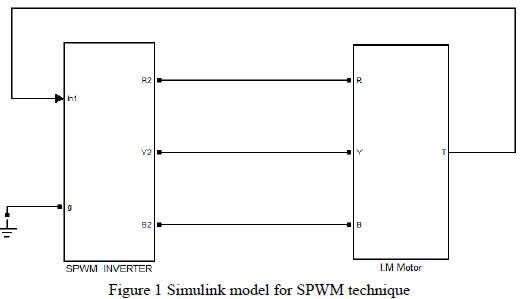 |
| The following Figure 2 shows the simulation model Inverter Circuit diagram. In this Inverter, unidirectional triangular carrier wave is compared with absolute value of reference sinusoidal wave. This output after comparison is then multiplied to 50% duty cycle signal. |
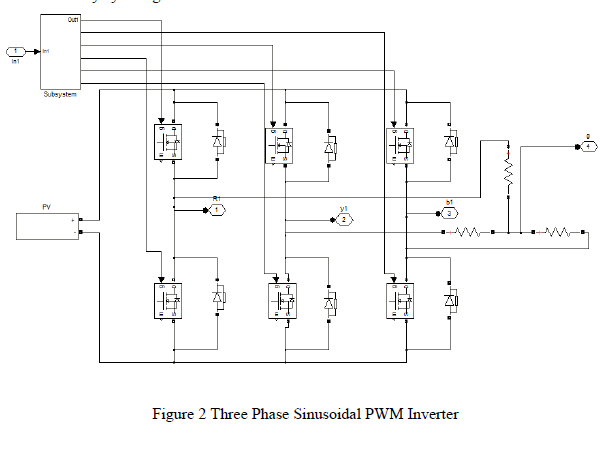 |
| The following Figure 3 shows the simulation model of three Phase Squirrel Cage Induction motor. In the Inverter circuit diagram MOSFET are mainly used. The output from the inverter is given to the input of the motor. |
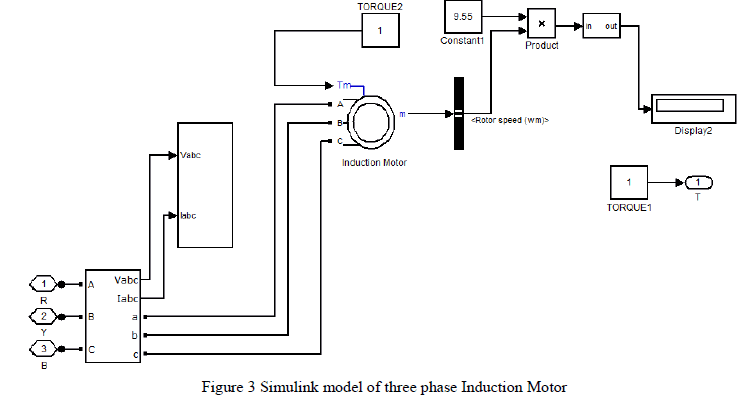 |
EXPERIMENTAL RESULTS WITH NEURAL NETWORK TOOL |
| The following Figure 4 shows the Simulation circuit diagram of PWM Pulse generation with Neural Network. |
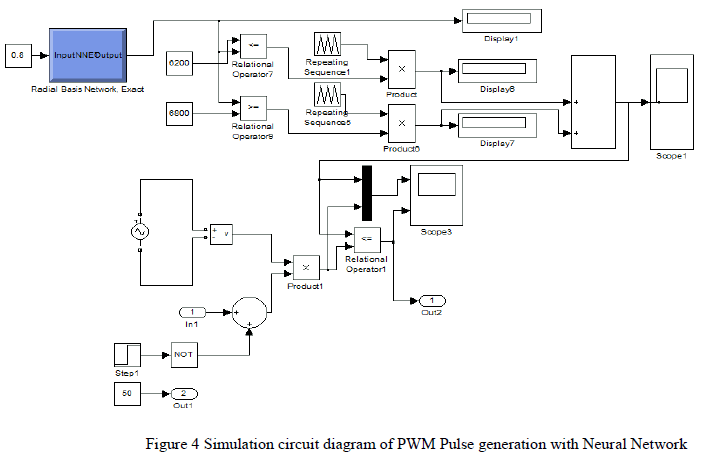 |
| The following Figure 5 shows the block diagram of Neural Network tool box. It gives simulink model output for the corresponding constant input. |
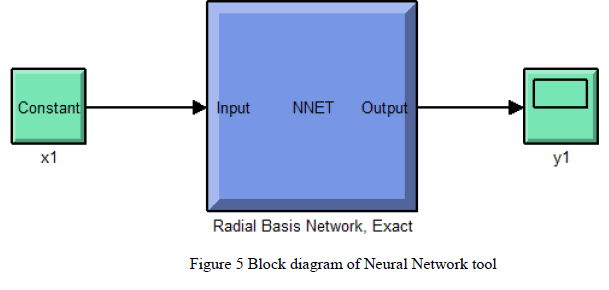 |
| The following Figure 6 shows the look under mask block diagram of Neural Network tool. |
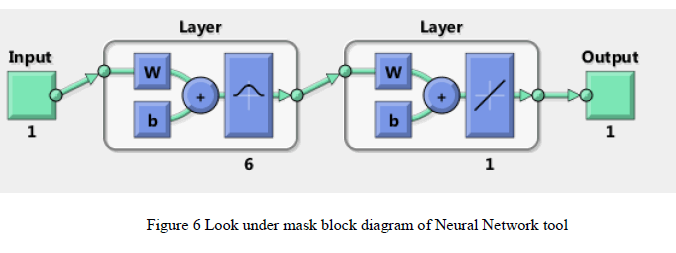 |
| A. Neural Network toolbox |
| The following Table 1 shows the feeding database into neural network toolbox. |
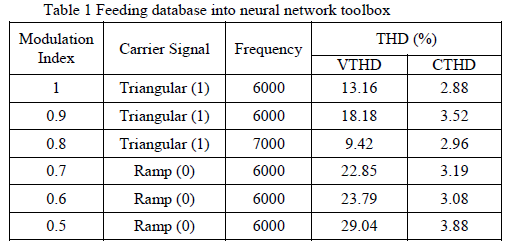 |
PERFORMANCE ANALYSIS OF SPWM TECHNIQUE |
| The following Table 2 shows the THD analysis of SPWM with triangular carrier signal by applying various Modulation Index value and Frequency. The modulation Index value of the reference signal and frequency of the triangular carrier signal are varied to find out the different VTHD and CTHD values. The reduced THD values are observed at the frequency rate of 7000 Hz and value of modulation index is 1. |
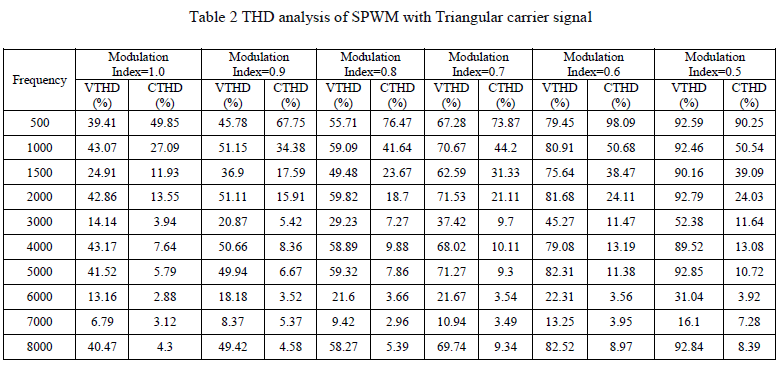 |
| The following Figure 7 shows the PWM pulse generation for SPWM with triangular carrier signal technique. Here, sinusoidal reference signal and triangular carrier signal provides PWM pulses. Figure 8 shows the gate signal waveform of SPWM with triangular carrier signal technique. |
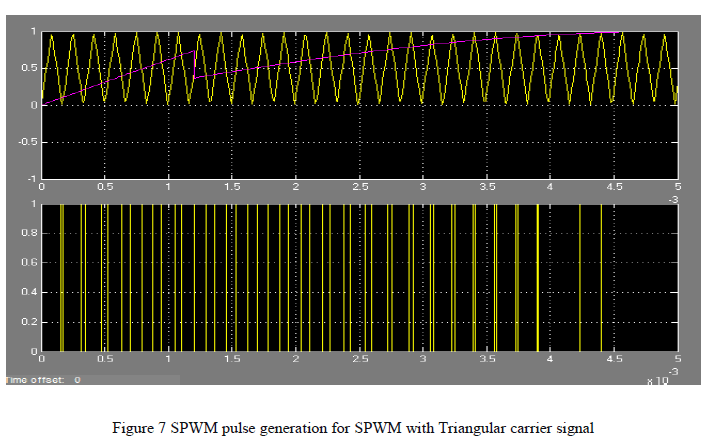 |
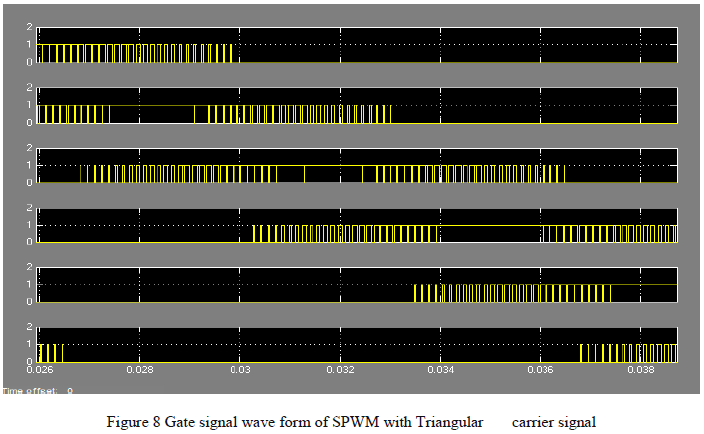 |
| The following Figure 9 and 10 shows the measurement of Current THD and Voltage THD at Inverter. |
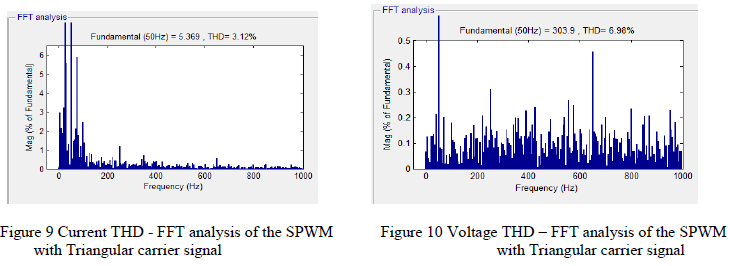 |
ACKNOWLEDGEMENT |
| Thank God and His almighty power to finish His research work by using me and my Project Guide my friend for His ultimate work. |
CONCLUSIONS |
| The results show that the harmonics distortion generated by the PV inverter was reduced by using Sinusoidal Pulse Width Modulation technique, there was reduction of VTHD by 6.98% and CTHD by 3.12%. Neural Network tool are used to select lowest THD values for a particular frequency, which provides effective target frequency value within short duration. At this condition we can connect the inverter line to grid system. |
References |
|